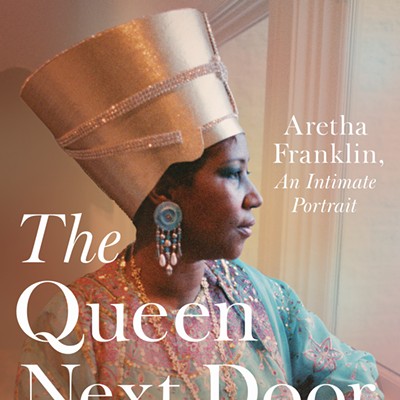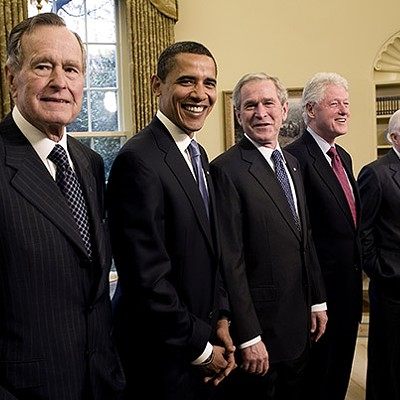The landlord, Mark Berman, "is giving me an offer I can't refuse," owner Scott Baker said earlier this month. "At this point, I'm not dead."
Located in a warehouse that occupies a whole city block at Sixth Street and Seventh Avenue, the fine photography gallery will continue on in its sleek white space for at least another year. The resurrection of Metroform is just one piece of good news in a gallery scene that suddenly seems a little brighter. Downtown boasts two new art venues: Flash opened in a temporary location on Congress Street in April, and Studio 180 debuted on Broadway Boulevard in February.
Metroform's Baker didn't want to disclose details of the deal that saved his gallery, but he said Berman will give him a big break on rent in exchange for a certain percentage of sales.
"I've already spent money fixing up the space," he pointed out. "It's better that it's occupied."
Mike Dominguez, co-owner of Davis Dominguez Gallery next door to Metroform and a fellow tenant of Berman's, negotiated the agreement.
"Mark Berman is an all-around supporter of the arts," Dominguez said. Berman's massive complex, formerly Tucson Transfer Warehouse, also houses the Ortspace run by O-T-O Dance. "I'm glad to have him as a landlord."
Baker, who doubles as a fine-art furniture maker, moved Metroform to the Warehouse District a year ago. He had weathered three years downtown on Stone Avenue, but moved to be near Davis Dominguez and what seemed like an up-and-coming warehouse scene. But with $15,000 a year in rent and overhead, he wasn't selling enough photography to make a go of it.
"It's better being next to Mike (Dominguez), but it's been slow," he said. "Getting Tucson people in here is hard."
Thinking the current show would be his last, Baker celebrated the gallery's run by exhibiting a group of 10 photographers who, with a couple of exceptions, had shown in the gallery before. It's a fine lineup, ranging from big race-car pictures by Jesse Alexander, a commercially successful photog from the '50s and '60s, to Thomas Bright's shimmering little Polaroid transfer prints, with shadowy architectural images of the barrio and other urbanscapes floating on glass.
Stu Jenks returns with flame-bright black-and-white images of last year's Aspen Fire on Mount Lemmon, and Jennifer Shaw of New Orleans reprises a couple of her delicately etched photos of warehouses and industrial sacks.
Baker is proud of the work he's shown, but said the whole enterprise has been "an emotional roller-coaster." He hopes the rent break will help him finance a booth at the annual Los Angeles and New York City trade shows that are becoming more crucial to a photography gallery's success. For the summer, he'll open the gallery only on Saturdays, and by fall, he hopes to enlist an intern to keep the hours in line with Davis Dominguez's five days a week.
There are rumblings that more galleries will open this fall in the Warehouse District, a development that can only help all the others, he said.
"A lot of galleries are here, but I wish it was more centralized, like in Phoenix. There they have a whole neighborhood with one gallery after another."
Right now, the Warehouse District boasts Metroform, Davis Dominguez, Santa Theresa Tileworks and Raices Taller, with the Drawing Studio and Dinnerware around the corner on Fourth. Downtown added 3Falk a year ago, and now Flash and Studio 180 have strengthened its gallery cluster. Santa Theresa Tileworks is scheduled to open an upscale coffee shop/cafe in September, which may add further vitality to the scene.
John Caverly, a painter and San Diego transplant, opened Studio 180 in the old Lewis Hotel building on Broadway Boulevard near Fifth Avenue, transforming the late Dr. Weiss' optometry shop into an elegant space with white walls and dark concrete floors. He specializes in contemporary art, a category he defines loosely enough to include rough-hewn figurative sculpture and paintings veering from abstract into expressionist. He also shows hand-made Carpathian rugs in crayon-bright colors.
"I really love it here in Tucson," Caverly said. "I moved here to open a gallery. Tucson is art-friendly, and it's becoming known for contemporary abstract art."
While he's planning a one-woman show of a French-Vietnamese painter named Kim-Loan Nguyen in the fall, right now he's offering a mix of 14 artists, about two-thirds from Tucson. Among them is Mary Theresa Dietz, a deft painter whose strangely alluring dog work, "The Sentinels," radiates sunshine yellows and browns right off the canvas. Caverly himself has switched to abstracts.
"The last 10 years I've been doing plein air and cityscape," he said, but the move to Tucson has inspired him to turn to pure form.
As an artist, he said, running his own gallery is the "easiest way to work in my studio and to show my own work."
Around the corner from Studio 180, Flash Gallery has materialized in the old Rialto Building on Congress Street, at least for the time being. Slated to be taken over by Congress Street Investors, a group that includes Doug Biggers, founder and former owner of the Tucson Weekly, the 1920 building has had a number of storefronts lying empty for some time. Since April, Flash has filled three of them with a changing roster of visual art and offered live music on weekend nights.
"We have one photography space and two more storefronts that make one large gallery," said Chrissy Goral, an artist who's managing the space for a cooperative of artists.
Right now, Flash's small photography gallery is showing eastern European black and whites by Bill Carter, a Bisbee photographer, and Rick Soloway's flashy neon-colored car pix. The main gallery has a group show of Flash artists, including Cait NiSimone's "In the Name of the Flowers, the Hermit and the Holy Cow," a self-portrait set in a murky Irish landscape, and Goral herself, who specializes in box constructions of found materials.
Goral said she and the other artists are delighted with the new venue.
"Doug Biggers allows us the space rent-free," she said, but, "It's up in the air how long we'll be able to stay."
In the spring, she and investor John Laswick, a former city staffer and a member of the Tucson Arts Coalition, approached Biggers about filling the empty storefronts with art. Biggers agreed, but he said that the arrangement is likely to be temporary. The building's facade is scheduled for renovation, and the Congress Street Investors are allowing the gallery to stay only until they rent out the spaces.
"The Flash Gallery has added vitality to what was a totally moribund block," Biggers said. "I think their plans are exciting, but I would caution that the future use of the Rialto Building will be largely dictated by the marketplace."
If Flash does have to leave, its artists are hoping they can pack up the idea and transfer it to another downtown location. Biggers suggested that the formula could be repeated elsewhere, with the cooperation of building owners. "I would encourage all downtown landlords with vacant spaces to put them to use in support of the arts, even on a temporary basis."
Added Goral, "It's a great thing. So many artists here don't have a place to show their work."














